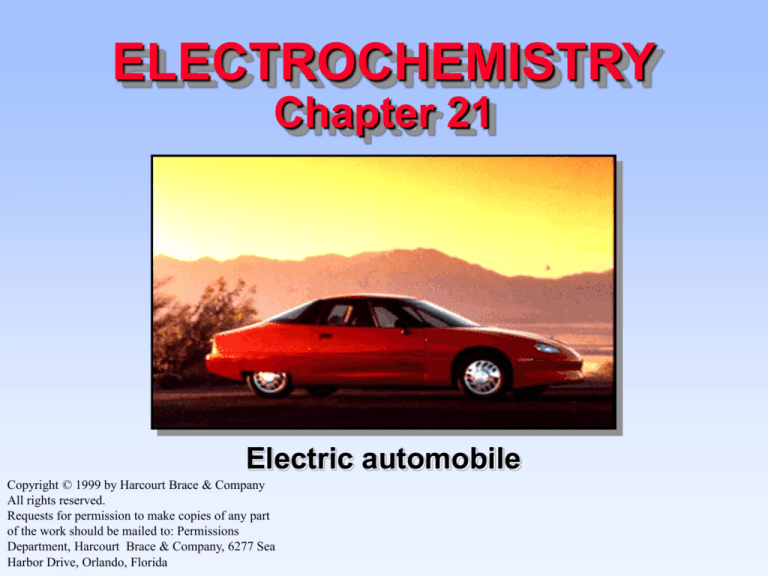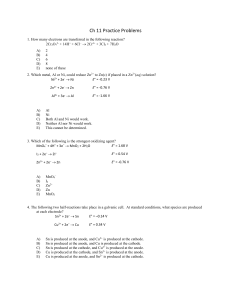
ELECTROCHEMISTRY
Chapter 21
Electric automobile
Copyright © 1999 by Harcourt Brace & Company
All rights reserved.
Requests for permission to make copies of any part
of the work should be mailed to: Permissions
Department, Harcourt Brace & Company, 6277 Sea
Harbor Drive, Orlando, Florida
2
TRANSFER REACTIONS
Atom transfer
HOAc + H2O ---> OAc- + H3O+
Electron transfer
Cu(s) + 2 Ag+(aq) ---> Cu2+(aq) + 2 Ag(s)
Copyright (c) 1999 by Harcourt Brace & Company
All rights reserved
3
Electron Transfer Reactions
• Electron transfer reactions are oxidationreduction or redox reactions.
• Redox reactions can result in the
generation of an electric current or be
caused by imposing an electric current.
• Therefore, this field of chemistry is often
called ELECTROCHEMISTRY.
Copyright (c) 1999 by Harcourt Brace & Company
All rights reserved
4
Review of Terminology for
Redox Reactions
• OXIDATION—loss of electron(s) by a
species; increase in oxidation number.
• REDUCTION—gain of electron(s);
decrease in oxidation number.
• OXIDIZING AGENT—electron acceptor;
species is reduced.
• REDUCING AGENT—electron donor;
species is oxidized.
Copyright (c) 1999 by Harcourt Brace & Company
All rights reserved
5
OXIDATION-REDUCTION
REACTIONS
Direct Redox Reaction
Oxidizing and reducing agents in direct
contact.
Cu(s) + 2 Ag+(aq) ---> Cu2+(aq) + 2 Ag(s)
Copyright (c) 1999 by Harcourt Brace & Company
All rights reserved
6
OXIDATION-REDUCTION
REACTIONS
Indirect Redox Reaction
A battery functions by transferring electrons
through an external wire from the reducing
agent to the oxidizing agent.
Copyright (c) 1999 by Harcourt Brace & Company
All rights reserved
Why Study Electrochemistry?
• Batteries
Copyright (c) 1999 by Harcourt Brace & Company
All rights reserved
7
Why Study Electrochemistry?
• Batteries
• Corrosion
A rusted car.
Copyright (c) 1999 by Harcourt Brace & Company
All rights reserved
8
Why Study Electrochemistry?
• Batteries
• Corrosion
• Industrial
production of
chemicals such as
Cl2, NaOH, F2 and
Al
A rusted car.
Copyright (c) 1999 by Harcourt Brace & Company
All rights reserved
9
Why Study Electrochemistry?
• Batteries
• Corrosion
• Industrial
production of
chemicals such as
Cl2, NaOH, F2 and
Al
• Biological redox
reactions
Copyright (c) 1999 by Harcourt Brace & Company
All rights reserved
The heme group
10
11
Electrochemical Cells
• An apparatus that allows
a redox reaction to occur
by transferring electrons
through an external
connector.
• Product favored reaction
---> voltaic or galvanic cell
----> electric current
• Reactant favored reaction
---> electrolytic cell --->
electric current used to
cause chemical change.
Copyright (c) 1999 by Harcourt Brace & Company
All rights reserved
Batteries are voltaic
cells
CHEMICAL CHANGE -->
ELECTRIC CURRENT
Zn
Zn metal
metal
With time, Cu plates out
onto Zn metal strip, and
Zn strip “disappears.”
2+ ions
Cu
Cu2+
ions
•Zn is oxidized and is the reducing agent
Zn(s) ---> Zn2+(aq) + 2e•Cu2+ is reduced and is the oxidizing agent
Cu2+(aq) + 2e- ---> Cu(s)
Copyright (c) 1999 by Harcourt Brace & Company
All rights reserved
12
CHEMICAL CHANGE -->
ELECTRIC CURRENT
Zn
Zn metal
metal
2+ ions
Cu
Cu2+
ions
Oxidation: Zn(s) ---> Zn2+(aq) + 2eReduction: Cu2+(aq) + 2e- ---> Cu(s)
-------------------------------------------------------Cu2+(aq) + Zn(s) ---> Zn2+(aq) + Cu(s)
Copyright (c) 1999 by Harcourt Brace & Company
All rights reserved
13
CHEMICAL CHANGE -->
ELECTRIC CURRENT
Zn
Zn metal
metal
2+ ions
Cu
Cu2+
ions
Electrons are
transferred from Zn to
Cu2+, but there is no
useful electric current.
Oxidation: Zn(s) ---> Zn2+(aq) + 2eReduction: Cu2+(aq) + 2e- ---> Cu(s)
-------------------------------------------------------Cu2+(aq) + Zn(s) ---> Zn2+(aq) + Cu(s)
Copyright (c) 1999 by Harcourt Brace & Company
All rights reserved
14
15
CHEMICAL CHANGE -->
ELECTRIC CURRENT
•To obtain a useful
current, we separate the
oxidizing and reducing
agents so that electron
transfer occurs thru an
external wire.
•This is accomplished in a
GALVANIC or VOLTAIC
cell.
•A group of such cells is
called a battery.
Copyright (c) 1999 by Harcourt Brace & Company
All rights reserved
wire
e le c t ro ns
Zn
Zn 2+ ions
salt
bridge
Cu
Cu2+ ions
16
wire
e le c t ro ns
Zn
Zn2+ ions
salt
bridge
Cu
Cu2+ ions
•Electrons travel thru external wire.
•Salt bridge allows anions and cations to
move between electrode compartments.
•This maintains electrical neutrality.
Copyright (c) 1999 by Harcourt Brace & Company
All rights reserved
17
Electrons move
from anode to
cathode in the wire.
Anions & cations
move thru the salt
bridge.
Electrochemical
Cell
Copyright (c) 1999 by Harcourt Brace & Company
All rights reserved
CELL POTENTIAL, E
Zn and Zn2+,
anode
Cu and Cu2+,
cathode
• Electrons are “driven” from anode to
cathode by an electromotive force or emf.
• For Zn/Cu cell, this is indicated by a voltage
of 1.10 V at 25 C and when [Zn2+] and [Cu2+]
= 1.0 M.
Copyright © 1999 by Harcourt Brace & Company
All rights reserved.
Requests for permission to make copies of any part
of the work should be mailed to: Permissions
Department, Harcourt Brace & Company, 6277 Sea
Harbor Drive, Orlando, Florida
19
CELL
POTENTIAL, E
• For Zn/Cu cell, voltage is 1.10 V at 25 C and
when [Zn2+] and [Cu2+] = 1.0 M.
• This is the STANDARD CELL
POTENTIAL, Eo
• —a quantitative measure of the tendency of
reactants to proceed to products when all
are in their standard states at 25 C.
Copyright (c) 1999 by Harcourt Brace & Company
All rights reserved
20
Calculating Cell Voltage
• Balanced half-reactions can be added
together to get overall, balanced
equation.
2 I- ---> I2 + 2e2 H2O + 2e- ---> 2 OH- + H2
------------------------------------------------2 I- + 2 H2O --> I2 + 2 OH- + H2
• If we know Eo for each half-reaction, we
could get Eo for net reaction.
Copyright (c) 1999 by Harcourt Brace & Company
All rights reserved
21
CELL POTENTIALS,
o
E
• Can’t measure 1/2 reaction Eo directly.
Therefore, measure it relative to a
STANDARD HALF CELL, SHE.
2 H+(aq, 1 M) + 2e- --> H2(g, 1 atm)
Eo = 0.0 V
Copyright (c) 1999 by Harcourt Brace & Company
All rights reserved
22
Zn/Zn2+ half-cell hooked to a SHE.
Eo for the cell = +0.76 V
Volts
-
Zn
+
Salt Bridge
H2
Zn2+
Zn
Zn2+ + 2eOXIDATION
ANODE
Copyright (c) 1999 by Harcourt Brace & Company
All rights reserved
H+
2 H+ + 2eH2
REDUCTION
CATHODE
23
Zn/Zn2+ half-cell hooked to a SHE.
Eo for the cell = +0.76 V
Volts
-
Zn
+
Salt Bridge
H2
Zn2+
Zn
Zn2+ + 2eOXIDATION
ANODE
Copyright (c) 1999 by Harcourt Brace & Company
All rights reserved
H+
2 H+ + 2eH2
REDUCTION
CATHODE
24
Volts
Zn
-
+
Salt Bridge
H2
Zn2+
Zn
Zn2+ + 2eOXIDATION
ANODE
H+
2 H+ + 2eH2
REDUCTION
CATHODE
Overall reaction is reduction of H+ by Zn metal.
Zn(s) + 2 H+ (aq) --> Zn2+ + H2(g)
Copyright (c) 1999 by Harcourt Brace & Company
All rights reserved
Eo = +0.76 V
25
Volts
Zn
-
+
Salt Bridge
H2
Zn2+
Zn
Zn2+ + 2eOXIDATION
ANODE
H+
2 H+ + 2eH2
REDUCTION
CATHODE
Overall reaction is reduction of H+ by Zn metal.
Zn(s) + 2 H+ (aq) --> Zn2+ + H2(g)
Eo = +0.76 V
Therefore, Eo for Zn ---> Zn2+ (aq) + 2e- is
Copyright (c) 1999 by Harcourt Brace & Company
All rights reserved
26
Volts
Zn
-
+
Salt Bridge
H2
Zn2+
Zn
Zn2+ + 2eOXIDATION
ANODE
H+
2 H+ + 2eH2
REDUCTION
CATHODE
Overall reaction is reduction of H+ by Zn metal.
Zn(s) + 2 H+ (aq) --> Zn2+ + H2(g)
Eo = +0.76 V
Therefore, Eo for Zn ---> Zn2+ (aq) + 2e- is
+0.76 V.
Copyright (c) 1999 by Harcourt Brace & Company
All rights reserved
27
Volts
Zn
-
+
Salt Bridge
H2
Zn2+
Zn
Zn2+ + 2eOXIDATION
ANODE
H+
2 H+ + 2eH2
REDUCTION
CATHODE
Overall reaction is reduction of H+ by Zn metal.
Zn(s) + 2 H+ (aq) --> Zn2+ + H2(g)
Eo = +0.76 V
Therefore, Eo for Zn ---> Zn2+ (aq) + 2e- is
+0.76 V.
Zn is a (better) (poorer) reducing agent than H2.
Copyright (c) 1999 by Harcourt Brace & Company
All rights reserved
28
Volts
Zn
-
+
Salt Bridge
H2
Zn2+
Zn
Zn2+ + 2eOXIDATION
ANODE
H+
2 H+ + 2eH2
REDUCTION
CATHODE
Overall reaction is reduction of H+ by Zn metal.
Zn(s) + 2 H+ (aq) --> Zn2+ + H2(g)
Eo = +0.76 V
Therefore, Eo for Zn ---> Zn2+ (aq) + 2e- is
+0.76 V.
Zn is a better reducing agent than H2.
Copyright (c) 1999 by Harcourt Brace & Company
All rights reserved
29
2+
Cu/Cu
and H2
+
/H
Cell
Volts
Cu
+
Salt Bridge
H2
Cu2+
Cu2+ + 2eCu
REDUCTION
CATHODE
Copyright (c) 1999 by Harcourt Brace & Company
All rights reserved
H+
H2
2 H+ + 2eOXIDATION
ANODE
30
Cu/Cu2+ and H2/H+ Cell
Eo = +0.34 V
Volts
Cu
+
Salt Bridge
H2
Cu2+
Cu2+ + 2eCu
REDUCTION
CATHODE
Copyright (c) 1999 by Harcourt Brace & Company
All rights reserved
H+
H2
2 H+ + 2eOXIDATION
ANODE
Cu/Cu2+ and H2/H+ Cell
31
Volts
Cu
+
Salt Bridge
H2
Cu2+
Cu2+ + 2eCu
REDUCTION
CATHODE
H+
H2
2 H+ + 2eOXIDATION
ANODE
• Overall reaction is reduction of Cu2+ by H2 gas.
Copyright (c) 1999 by Harcourt Brace & Company
All rights reserved
Cu/Cu2+ and H2/H+ Cell
32
Volts
Cu
+
Salt Bridge
H2
Cu2+
Cu2+ + 2eCu
REDUCTION
CATHODE
H+
H2
2 H+ + 2eOXIDATION
ANODE
• Overall reaction is reduction of Cu2+ by H2 gas.
• Cu2+ (aq) + H2(g) ---> Cu(s) + 2 H+(aq)
• Measured Eo = +0.34 V
Copyright (c) 1999 by Harcourt Brace & Company
All rights reserved
Cu/Cu2+ and H2/H+ Cell
33
Volts
Cu
+
Salt Bridge
H2
Cu2+
Cu2+ + 2eCu
REDUCTION
CATHODE
•
•
•
•
H+
H2
2 H+ + 2eOXIDATION
ANODE
Overall reaction is reduction of Cu2+ by H2 gas.
Cu2+ (aq) + H2(g) ---> Cu(s) + 2 H+(aq)
Measured Eo = +0.34 V
Therefore, Eo for Cu2+ + 2e- ---> Cu is
Copyright (c) 1999 by Harcourt Brace & Company
All rights reserved
Cu/Cu2+ and H2/H+ Cell
34
Volts
Cu
+
Salt Bridge
H2
Cu2+
Cu2+ + 2eCu
REDUCTION
CATHODE
•
•
•
•
H+
H2
2 H+ + 2eOXIDATION
ANODE
Overall reaction is reduction of Cu2+ by H2 gas.
Cu2+ (aq) + H2(g) ---> Cu(s) + 2 H+(aq)
Measured Eo = +0.34 V
Therefore, Eo for Cu2+ + 2e- ---> Cu is
• +0.34 V
Copyright (c) 1999 by Harcourt Brace & Company
All rights reserved
Cu/Cu2+ and H2/H+ Cell
Volts
Cu
+
Salt Bridge
H2
Cu2+
Cu2+ + 2eCu
REDUCTION
CATHODE
H+
H2
2 H+ + 2eOXIDATION
ANODE
• Eo for Cu2+ + 2e- ---> Cu is +0.34 V
• Now we can calculate Eo for the Zn/Cu cell.
Copyright (c) 1999 by Harcourt Brace & Company
All rights reserved
35
Zn/Cu Electrochemical Cell
wire
elect rons
Zn
Anode,
negative,
source of
electrons
Zn2+ ions
salt
bridge
Cu
Cu2+ ions
Cathode,
positive,
sink for
electrons
Zn(s) ---> Zn2+(aq) + 2eEo = +0.76 V
Cu2+(aq) + 2e- ---> Cu(s)
Eo = +0.34 V
--------------------------------------------------------------Cu2+(aq) + Zn(s) ---> Zn2+(aq) + Cu(s)
Eo (calc’d) = +1.10 V
Copyright (c) 1999 by Harcourt Brace & Company
All rights reserved
36
Uses of Eo Values
These experiments show we can
a)
decide on relative ability of
elements to act as reducing agents (or
oxidizing agents)
b)
assign a voltage to a half-reaction
that reflects this ability.
wire
elect rons
Zn
Zn2+ ions
Copyright (c) 1999 by Harcourt Brace & Company
All rights reserved
salt
bridge
Cu
Cu2+ ions
37
38
TABLE OF STANDARD
POTENTIALS
oxidizing
ability of ion
Eo (V)
Cu2+ + 2e-
Cu
+0.34
2 H+ + 2e-
H2
0.00
Zn2+ + 2e-
Zn
-0.76
Copyright (c) 1999 by Harcourt Brace & Company
All rights reserved
reducing ability
of element
39
Standard Redox Potentials, Eo
oxidizing
ability of ion
Eo (V)
Cu2+ + 2e-
Cu
+0.34
2 H+ + 2e-
H2
0.00
Zn2+ + 2e-
Zn
-0.76
reducing ability
of element
Copyright (c) 1999 by Harcourt Brace & Company
All rights reserved
• Any substance on the
right will reduce any
substance higher than it
on the left.
• Zn can reduce H+ and
Cu2+.
• H2 can reduce Cu2+ but
not Zn2+
• Cu cannot reduce H+ or
Zn2+.
40
Using Standard Potentials, Eo
• See Table 21.1 or Screen 21.6.
• Which is the best oxidizing agent:
O2, H2O2, or Cl2? _________________
• Which is the best reducing agent:
Hg, Al, or Sn? ____________________
• In which direction does the following
reaction go?
Cu(s) + 2 Ag+(aq) ---> Cu2+(aq) + 2 Ag(s)
Copyright (c) 1999 by Harcourt Brace & Company
All rights reserved
o
E
for a Voltaic Cell
Volts
Cd
Cd2+
Cd --> Cd2+ + 2eor
Cd2+ + 2e- --> Cd
Copyright (c) 1999 by Harcourt Brace & Company
All rights reserved
Fe
Salt Bridge
Fe2+
Fe --> Fe2+ + 2eor
Fe2+ + 2e- --> Fe
41
o
E
for a Voltaic Cell
Volts
Cd
Fe
Salt Bridge
Cd2+
Copyright (c) 1999 by Harcourt Brace & Company
All rights reserved
Fe2+
From the table, you see
• Fe is a better reducing
agent than Cd
• Cd2+ is a better
oxidizing agent than
Fe2+
Overall reaction
Fe + Cd2+
---> Cd + Fe2+
Eo = +0.04 V
42
43
o
E
and D
o
G
Eo is related to DGo, the free
energy change for the reaction.
o
DG
= -nF
o
E
where F = Faraday constant
= 9.6485 x 104 J/V•mol
and n is the number of moles of
electrons transferred
Michael Faraday
1791-1867
Copyright (c) 1999 by Harcourt Brace & Company
All rights reserved
44
Michael Faraday
1791-1867
Originated the terms anode,
cathode, anion, cation,
electrode.
Discoverer of
• electrolysis
• magnetic props. of matter
• electromagnetic induction
• benzene and other organic
chemicals
Was a popular lecturer.
Copyright (c) 1999 by Harcourt Brace & Company
All rights reserved
Eo and DGo
DGo = - n F Eo
For a product-favored reaction
Reactants ----> Products
DGo < 0 and so Eo > 0
Eo is positive
For a reactant-favored reaction
Reactants <---- Products
DGo > 0 and so Eo < 0
Eo is negative
Copyright (c) 1999 by Harcourt Brace & Company
All rights reserved
45







